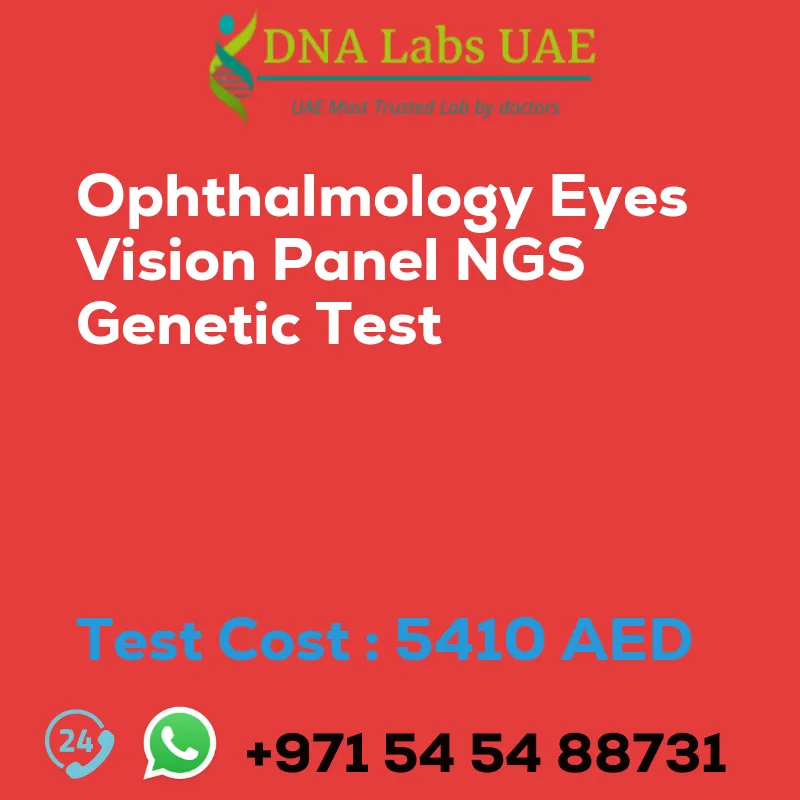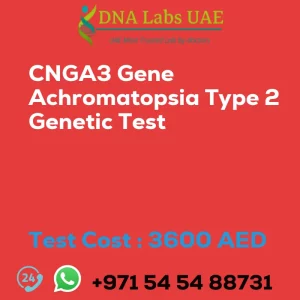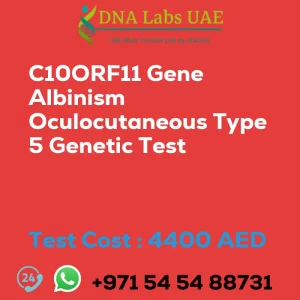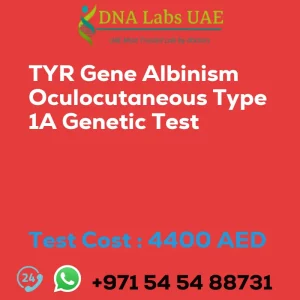Ophthalmology Eyes Vision Panel NGS Genetic Test
At DNA Labs UAE, we offer the Ophthalmology Eyes Vision Panel NGS Genetic Test, which is a comprehensive genetic test that analyzes a person’s DNA to identify genetic variations associated with eye and vision conditions. This test can provide valuable information about a person’s genetic risk for conditions such as age-related macular degeneration, glaucoma, cataracts, and retinitis pigmentosa.
Test Details
The Ophthalmology Eyes Vision Panel NGS Genetic DNA Test utilizes Next-Generation Sequencing (NGS) technology to analyze multiple genes simultaneously. By examining variations in genes known to play a role in eye and vision health, this test offers a comprehensive view of a person’s genetic makeup related to these conditions.
Test Components
The price for the Ophthalmology Eyes Vision Panel NGS Genetic DNA Test is 5410.0 AED. The sample condition required for this test is blood or extracted DNA, or one drop of blood on an FTA card. The report delivery typically takes 3 to 4 weeks.
Test Method
NGS technology is used to analyze the genetic material obtained from the sample. This advanced sequencing method allows for the simultaneous examination of multiple genes, providing accurate and comprehensive results.
Test Type
The Ophthalmology Eyes Vision Panel NGS Genetic DNA Test falls under the category of Ophthalmology Disorders. It is specifically designed to identify genetic variations associated with eye and vision conditions.
Pre-Test Information
Before undergoing the Ophthalmology Eyes Vision Panel NGS Genetic DNA Test, it is important to provide the clinical history of the patient. Additionally, a genetic counseling session may be conducted to draw a pedigree chart of family members affected by specific genes, such as ABCA4, ABCB6, ABHD12, and many others.
How the Test Works
The Ophthalmology Eyes Vision Panel NGS Genetic DNA Test requires a sample of the patient’s DNA, which is typically collected through a blood or saliva sample. Once the sample is obtained, it is sent to our laboratory for analysis. The results are then interpreted by a genetic counselor or healthcare provider.
Benefits of the Test
The Ophthalmology Eyes Vision Panel NGS Genetic DNA Test provides valuable information about a person’s genetic risk for eye and vision conditions. This allows for early detection and personalized treatment plans, leading to better management of these conditions.
Don’t wait until it’s too late. Take control of your eye and vision health with the Ophthalmology Eyes Vision Panel NGS Genetic DNA Test at DNA Labs UAE.
| Test Name | Ophthalmology Eyes Vision Panel NGS Genetic DNA Test |
|---|---|
| Components | |
| Price | 5410.0 AED |
| Sample Condition | Blood or Extracted DNA or One drop Blood on FTA Card |
| Report Delivery | 3 to 4 Weeks |
| Method | NGS Technology |
| Test type | Ophthalmology Disorders |
| Doctor | Ophthalmologist |
| Test Department: | Genetics |
| Pre Test Information | Clinical History of Patient who is going for Ophthalmology Eyes Vision Panel NGS Genetic DNA Test. A Genetic Counselling session to draw a pedigree chart of family members affected with ABCA4, ABCB6, ABHD12, ACO2, ACVR1, ADAM9, ADGRV1, AFG3L2, AGK, AHI1, AIPL1, ALDH18A1, ALDH1A3, AP3B1, APTX, ARL13B, ARL6, ASB10, ATF6, AUH, B9D1, B9D2, BBS1, BBS10, BBS12, BBS2, BBS4, BBS5, BBS7, BBS9, BCOR, BEST1, BFSP1, BFSP2, BLOC1S3, BLOC1S6, BMP4, C12orf65, C1QTNF5, C8orf37, CA4, CABP4, CACNA1F, CACNA2D4, CANT1, CC2D2A, CCDC28B, CDH23, CDH3, CDHR1, CEP164, CEP290, CEP41, CERKL, CHD7, CHM, CHMP4B, CIB2, CISD2, CLCN7, CLN3, CLN5, CLN6, CLN8, CLPB, CLRN1, CNGA1, CNGA3, CNGB1, CNGB3, CNNM4, COL11A1, COL11A2, COL2A1, COL4A1, COL9A1, COL9A2, COL9A3, COX7B, CPLANE1, CRB1, CRX, CRYAA, CRYAB, CRYBA1, CRYBA4, CRYBB1, CRYBB2, CRYBB3, CRYGB, CRYGC, CRYGD, CRYGS, CSPP1, CTC1, CTDP1, CTNNB1, CTSD, CYP1B1, CYP27A1, DGUOK, DHDDS, DKC1, DNA2, DNAJC19, DNM1L, DTNBP1, EDN3, EDNRB, EFEMP1, ELOVL4, ENPP1, EPHA2, ERCC1, ERCC2, ERCC5, ERCC6, EYA1, EYS, FAM126A, FAM161A, FLVCR1, FOXC1, FOXE3, FOXL2, FRAS1, FREM1, FREM2, FSCN2, FTL, FYCO1, FZD4, GALE, GALK1, GALT, GBA, GCNT2, GDF3, GDF6, GJA1, GJA3, GJA8, GNAT2, GNPTG, GPR143, GRIP1, GRN, GUCA1A, GUCA1B, GUCY2D, HCCS, HESX1, HEXA, HGSNAT, HK1, HMX1, HPS1, HPS3, HPS4, HPS5, HPS6, HSF4, HTRA2, IDH3B, IFT140, IFT172, IFT27, IMPDH1, IMPG2, INPP5E, IQCB1, KCNJ13, KCNV2, KIF11, KIF7, KIT, KLHL7, LCA5, LEMD2, LEP, LEPR, LIM2, LMX1B, LOXL1, LRAT, LRMDA, LRP2, LRP5, LSS, LTBP2, LYST, LZTFL1, MAB21L2, MAF, MAK, MC1R, MERTK, MFN2, MFRP, MFSD8, MIP, MITF, MKKS, MKS1, MLPH, MYH9, MYO5A, MYO7A, MYOC, NAA10, NDP, NF2, NHS, NMNAT1, NPHP1, NPHP3, NPHP4, NR0B2, NR2F1, NRL, NTF4, OCA2, OCRL, OFD1, OPA1, OPA3, OPN1LW, OPN1MW, OPTN, OSTM1, OTX2, P3H2, PAX2, PAX3, PAX6, PCARE, PCDH15, PDE6A, PDE6B, PDE6C, PDE6G, PDE6H, PDZD7, PEX1, PEX2, PEX7, PHF6, PHYH, PIK3R5, PITPNM3, PITX2, PITX3, PLA2G5, PNKP, PNPLA6, POLG, POLG2, POMC, POMGNT1, PPARG, PPT1, PQBP1, PRCD, PRKCG, PROM1, PRPF3, PRPF31, PRPF6, PRPF8, PRPH2, PRPS1, PRSS56, RAB18, RAB27A, RAB3GAP1, RAB3GAP2, RARB, RAX, RAX2, RBP3, RBP4, RD3, RDH12, RDH5, RGR, RGS9, RGS9BP, RHO, RIMS1, RLBP1, ROM1, RP1, RP1L1, RP2, RPE65, RPGR, RPGRIP1, RPGRIP1L, RRM2B, RS1, RTN4IP1, SAG, SBF2, SDCCAG8, SEMA4A, SERAC1, SETX, SHH, SIL1, SIX3, SIX6, SLC16A12, SLC24A5, SLC25A4, SLC25A46, SLC33A1, SLC45A2, SLC9A6, SMCHD1, SMOC1, SNAI2, SNRNP200, SNX10, SOX10, SOX2, SPATA7, SPG7, STRA6, TBC1D20, TBK1, TCIRG1, TCTN1, TCTN2, TCTN3, TDRD7, TENM3, TFAP2A, TIMM8A, TIMP3, TK2, TMEM126A, TMEM138, TMEM216, TMEM231, TMEM237, TMEM67, TMEM70, TNFRSF11A, TNFSF11, TOPORS, TPP1, TRIM32, TRNT1, TSPAN12, TTC21B, TTC8, TTPA, TULP1, TWNK, TYMP, TYR, TYRP1, UNC45B, USH1C, USH1G, USH2A, VCAN, VIM, VPS13B, VSX2, WDPCP, WDR19, WDR36, WFS1, WHRN, ZIC2, ZNF423, ZNF513 |
| Test Details | The Ophthalmology Eyes Vision Panel NGS Genetic DNA Test is a genetic test that analyzes a person’s DNA to identify genetic variations that may be associated with eye and vision conditions. The test looks for variations in genes that are known to play a role in conditions such as age-related macular degeneration, glaucoma, cataracts, and retinitis pigmentosa. NGS (Next-Generation Sequencing) technology is used to analyze multiple genes simultaneously, providing a comprehensive view of a person’s genetic makeup related to eye and vision health. The test can help identify individuals who may be at increased risk for developing these conditions, allowing for early detection and treatment. The Ophthalmology Eyes Vision Panel NGS Genetic DNA Test is typically ordered by a healthcare provider and involves collecting a sample of the patient’s DNA, usually through a blood or saliva sample. The sample is then sent to a laboratory for analysis, and the results are interpreted by a genetic counselor or healthcare provider. Overall, this test can provide valuable information about a person’s genetic risk for eye and vision conditions, allowing for personalized treatment and management plans. |





